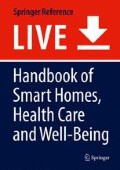Abstract
The focus of this chapter is on designing for smart homes. The perspective will be user-driven design research. The chapter starts with a context analysis of the home environment. This analysis shows that, from a user perspective, home is about emotions and not about the physical house with all its smart applications. It is this “home experience” designers have to design for. The core of the chapter consists of the description of three big challenges that modern designers (need to) face when designing or studying smart home environments. These challenges are linked to existing and future design paradigms. The following challenges are addressed: (1) What makes a worthwhile user experience? (2) How to design for user experience? (3) How to design for user experiences that can be seamlessly integrated in everyday life? The chapter concludes with a summary of the main insights that emerge from current design research practice facing these challenges.
Notes
- 1.
A statement made by participants of a study on the home experience by Eggen et al. (2003a).
References
Bakker S, van den Hoven E, Eggen JH (2012) Knowing by ear: leveraging human attention abilities in interaction design. J Multimodal User Interfaces 5(3):197–209, a special issue of “Interactive sonification”
Baron-Cohen S (2003) The essential difference: the truth about the male and female brain. Basic Books, New York
Benyon D, Turner P, Turner S (2005) Designing interactive systems: people, activities, contexts, technologies. Pearson Education, Harlow
Brand R, Rocchi S (2011) Rethinking value in a changing landscape – a model for strategic reflection and business transformation, Philips Design. http://www.design.philips.com/philips/shared/assets/design_assets/pdf/nvbD/april2011/paradigms.pdf. Retrieved 12 Jan 2014
Carroll JM (2000) Making use: scenario-based design of human-computer interactions. MIT Press, Cambridge
de Waal FBM (2008) Putting the altruism back into altruism: the evolution of empathy. Annu Rev Psychol 59:279–300
Eggen B, Kyffin S (2006) Experience design. In: Aarts E, Encarnação JL (eds) True visions: the emergence of ambient intelligence. Springer, Berlin, pp 359–376
Eggen JH, Hollemans G, van de Sluis R (2003a) Exploring and enhancing the home experience. J Cogn Technol Work 5:44–54, Springer: London
Eggen JH, Rozendaal M, Schimmel O (2003b) Home radio – extending the home experience beyond the boundaries of the physical house. In: HOIT 2003 (Home Oriented Informatics and Telematics) international conference on “the networked home and the home of the future”. University of California, Irvine, 6–8 Apr 2003. http://www.crito.uci.edu/NOAH/HOIT/HOIT%20Papers/HomeRadio.pdf. Retrieved 16 Feb 2014
Hassenzahl M (2010) Experience design – technology for all the right reasons. Morgan & Claypool, San Rafael
Hassenzahl M (2011) Encyclopedia entry on user experience and experience design. http://www.interaction-design.org/encyclopedia/user_experience_and_experience_design.html. Retrieved 12 Jan 2014
ISO 9241–11 (1998) Ergonomic requirements for office work with visual display terminals (VDTs) – part 11: guidance on usability. http://www.iso.org/iso/catalogue_detail.htm?csnumber=16883. Retrieved 17 Oct 2014
ISO 9241–210 (2010) Ergonomics of human-system interaction – part 210: human-centered design for interactive systems. http://www.iso.org/iso/catalogue_detail.htm?csnumber=52075. Retrieved 17 Oct 2014
Jordan PW (2000) Designing pleasurable products: an introduction to the new human factors. Taylor & Francis, London
Offermans SAM, van Essen HA, Eggen JH (2014) User interaction with everyday lighting systems. Pers Ubiquit Comput J. doi:10.1007/s00779-014-0759-2. Published online, February 1, 2014
Ozcelik D, Terken JMB (2012) Co-constructing stories: a participatory design technique to elicit in-depth user feedback and suggestions about design concepts. In: Oral: PDC’12 proceedings of the 12th participatory design conference: exploratory papers, workshop descriptions, industry cases – vol 2. ACM, New York, pp 33–36
Rogers Y, Sharp H, Preece J (2011) Interaction design: beyond human – computer interaction, 3rd edn. Wiley, Chichester
Roto V, Law E, Vermeeren A, Hoonhout J (eds) (2011) User experience white paper – bringing clarity to the concept of user experience. Result from Dagstuhl seminar on demarcating user experience, 15–18 Sept 2010. http://www.allaboutux.org/files/UX-WhitePaper.pdf. Retrieved 15 Feb 2014
Sanders L (2008) An evolving map of design practice and design research. http://www.dubberly.com/wp-content/uploads/2009/01/ddo_article_evolvingmap.pdf. Retrieved 16 Feb 2014
Schwartz W (2002) From passivity to competence: a conceptualization of knowledge, skill, tolerance and empathy. Psychiatry 65:338–345
Sheldon KM, Elliot AJ, Kim Y, Kasser T (2001) What’s satisfying about satisfying events? Comparing ten candidate psychological needs. J Pers Soc Psychol 80:325–339
Turkle S (2011) Alone together: why we expect more from technology and less from each other. Basic Books, New York
van den Hoven E, Eggen B (2008) Informing augmented memory system design through autobiographical memory theory. Pers Ubiquit Comput J 12(6):433–443
Visser FS, Stappers PJ, van der Lugt R, Sanders EBN (2005) Contextmapping: experiences from practice. CoDesign 1(2):119–149
Weiser M, Brown JS (1997) The coming age of calm technology. In: Denning PJ, Metcalfe RM (eds) Beyond calculation: the next fifty years of computing. Springer, New York, pp 75–85
Author information
Authors and Affiliations
Corresponding author
Editor information
Editors and Affiliations
Rights and permissions
Copyright information
© 2014 Springer International Publishing Switzerland
About this entry
Cite this entry
Eggen, B., van den Hoven, E., Terken, J. (2014). Human-Centered Design and Smart Homes: How to Study and Design for the Home Experience?. In: van Hoof, J., Demiris, G., Wouters, E. (eds) Handbook of Smart Homes, Health Care and Well-Being. Springer, Cham. https://doi.org/10.1007/978-3-319-01904-8_6-1
Download citation
DOI: https://doi.org/10.1007/978-3-319-01904-8_6-1
Received:
Accepted:
Published:
Publisher Name: Springer, Cham
Online ISBN: 978-3-319-01904-8
eBook Packages: Springer Reference EngineeringReference Module Computer Science and Engineering

